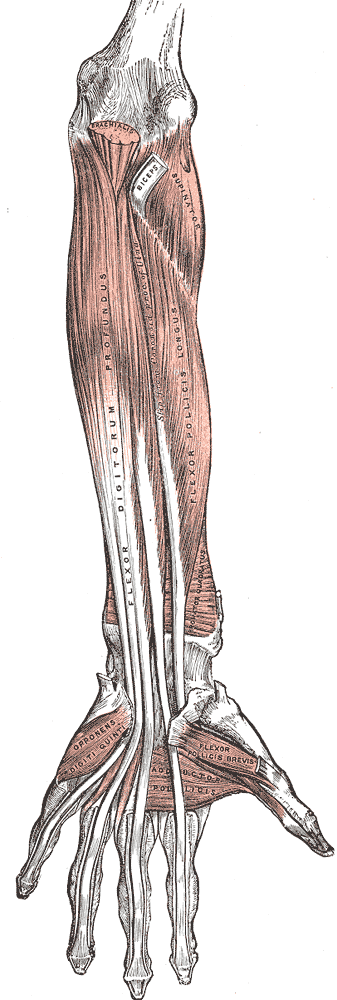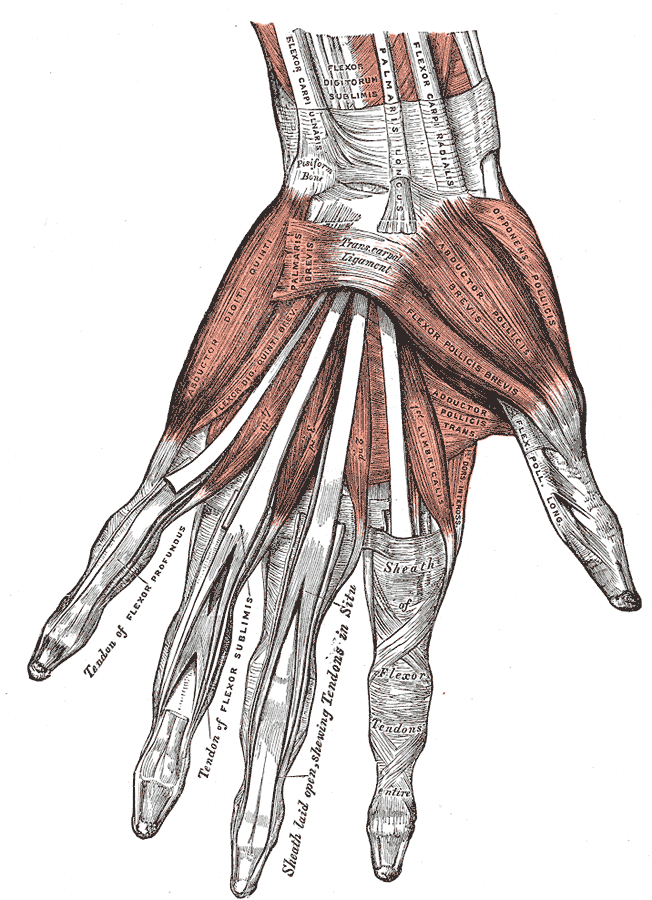Muscles associated with the wrist include those of the forearm and hand that move the wrist and digits. The wrist and hand exhibit a remarkable range of movement, key for grasping and interaction with objects. These muscles can generate highly variable force, from the strong grip required when lifting a heavy object to the delicate movements required to write.
Muscles of the forearm that act on the wrist and hand are referred to as extrinsic muscles, or external to the hand. Those located within the hand are referred to as intrinsic.
Muscles of the Forearm
As with the upper arm, the forearm is split into anterior and posterior compartment. Each contains many more muscles than described below due to the requirement for more complex movements in the wrist and hand.
Anterior
The anterior compartment of the forearm is split into superficial, intermediate, and deep layers. These muscles are generally responsible for flexing of the wrist and fingers and pronation of the forearm.
Superficial Layer
Three muscles are located in the superficial layer of the anterior compartment of the forearm.
Flexor Carpi Ulnaris – A long muscle originating near the elbow and passing through into the wrist.
- Attachments - Originates from the humerus and ulna and attaches to one of the carpal bones in the wrist.
- Actions - Flexion and adduction at the wrist.
Palmaris Longus - A long muscle originating near the elbow and passing through into the wrist.
- Attachments - Originates from the humerus and attaches to the base of the hand.
- Actions - Flexion at the wrist.
Flexor Carpi Radialis - A long muscle originating near the elbow and passing through into the wrist.
- Attachments - Originates from the humerus and attaches to the base of the digits.
- Actions - Flexion and abduction at the wrist.
Pronator Teres – A rectangular muscle.
- Attachments - The pronator teres has two origins, one on the proximal end of the humerus and one of the distal end of the ulna. It attaches to the mid region of the radius.
- Actions - Pronates the forearm.
Intermediate Layer
There is just one muscle in the intermediate layer of the anterior compartment of the forearm.
Flexor Digitorum Superficialis – Lying below the superficial region, the flexor digitorum superficialis is a key muscle controlling wrist and finger flex.
- Attachments – Originates from the humerus and the radius, splitting into four tendons at the wrist which travel through the carpal tunnel and attach to the fingers.
- Actions - Flexes fingers and wrist.
Deep Layer
There are three muscles in the deep layer of the anterior compartment of the forearm.
Flexor Digitorum Profundus - A long muscle originating near the elbow and passing through into the wrist, lying adjacent to the flexor pollicis longus.
- Attachments - Originates from the ulna, splitting into four tendons at the wrist which travel through the carpal tunnel and attach distally to the fingers.
- Actions – Flexes the wrist and the most distal regions of the fingers.
Flexor Pollicis Longus - A long muscle originating near the elbow and passing through into the wrist, lying adjacent to the flexor digitorum profundus.
- Attachments - Originates from the radius and attaches to the base of the thumb.
- Actions - Flexes the thumb.
Pronator quadratus - A square-shaped muscle located adjacent to the wrist.
- Attachments - Originates from the ulna and attaches to the radius.
- Actions - Pronates the forearm.
Posterior
The posterior compartment of the forearm is split into superficial and deep regions. The muscles are generally responsible for extension of the wrist and fingers.
Superficial Layer
The superficial layer of the posterior forearm contains seven muscles.
Aconeus - The aconeus is located in the superficial region of the forearm posterior compartment and is blended with the triceps brachii.
- Attachments - Originates from the humerus and attaches to the ulna.
- Actions - Moves the ulna during pronation and extends the forearm at the elbow.
Brachioradialis - The brachioradialis is located in the superficial region of the forearm posterior compartment.
- Attachments - Originates from the humerus and attaches to the distal end of the radius.
- Actions - Flexes the forearm at the elbow.
Extensor Carpi Radialis Longus and Brevis – A pair of muscles located on the side of the forearm, allowing them to control extension and abduction of the wrist.
- Attachments – Both originate from the humerus and attach to the base of the hand.
- Actions - Extend and abduct the wrist.
Extensor Digitorum - The extensor digitorum is the main extensor of the fingers.
- Attachments - Originates from the humerus, splitting into four tendons at the wrist which travel through the carpal tunnel and attach to the digits.
- Actions - Extends fingers.
Extensor Digiti Minimi – Originates from the extensor digitorum. In some people, these muscles cannot be individually defined.
- Attachments - Originates from the humerus and attaches to the little finger.
- Actions - Extends the little finger, and contributes to extension at the wrist.
Extensor Carpi Ulnaris – Located on the other side of the forearm to the extensor carpi radialis longus and brevis, it performs a similar role.
- Attachments - Originates from the humerus and attaches to the base of the hand.
- Actions - Extension and adduction of wrist.
Deep Layer
There are four muscles in the deep layer of the posterior compartment of the forearm.
Supinator - The supinator is located in the deep region of the forearm posterior compartment.
- Attachments - The supinator has two heads: one originates from the humerus, the other from the ulna. Together they attach to the radius.
- Actions - Supinates the forearm.
Abductor Pollicis Longus – The abductor pollicis longus is situated immediately distal to the supinator muscle.
- Attachments - Originates from the radius and ulna attaching to the base of the thumb.
- Actions - Abducts the thumb.
Extensor Pollicis Brevis – The extensor pollicis brevis is located below the abductor pollicis longus.
- Attachments - Originates from radius and attaches to the base of the thumb.
- Actions - Extends the thumb.
Extensor Indicis Proprius - This muscle allows the index finger to be independent of the other fingers during extension.
- Attachments - Originates from the ulna and attaches to the index finger.
- Actions - Extends the index finger.

Muscles and tendons of the forearm and hand
The extrinsic muscles of the forearm are responsible for movement of the wrist and fingers. Often providing the more forceful movements required.
Muscles of the Hand
The extrinsic muscles of the hand are responsible for the larger scale, stronger movements of the wrist and hand. The intrinsic muscles produce finer, more controlled movements and play important roles in maintaining grip.
Thenar Muscles
The thenar muscles are three short muscles located at the base of the thumb and responsible for its fine movement.
Opponens Pollicis - The opponens pollicis is the largest and deepest-lying of the thenar muscles.
- Attachments - Originates from the wrist and attaches to the thumb.
- Actions – Rotates the thumb towards the palm, producing opposition and improving grip.
Abductor Pollicis Brevis – Located anteriorly to the opponens pollicis and proximal to the flexor pollicis brevis.
- Attachments - Originates from the wrist and attaches to the thumb.
- Actions - Abducts the thumb.
Flexor Pollicis Brevis – The smallest and most distal of the thenar muscles.
- Attachments - Originates from the wrist and attaches to the thumb.
- Actions - Flexes the thumb.
Hypothenar Muscles
The hypothenar muscles are located at the base of the little finger. Their naming, function, and organization are similar to those of the thenar muscles.
Opponens Digiti Minimi - The opponens digit minimi is the deepest-lying of the hypothenar muscles.
- Attachments - Originates from the wrist and attaches to the little finger.
- Actions - Rotates little finger towards the palm, producing opposition and improving grip.
Abductor Digiti Minimi - The most superficial of the hypothenar muscles.
- Attachments - Originates from the wrist and attaches to the little finger.
- Actions - Abducts the little finger.
Flexor Digiti Minimi Brevis – Located laterally to the digiti minimi.
- Attachments - Originates from the wrist and attaches to the little finger.
- Actions - Flexes little finger.
Lumbricals
These are four lumbricals in the hand, each associated with an individual finger.
- Attachments - Originates from a tendon of attached to the flexor digitorum profundus of the forearm, each attaching to an individual finger
- Actions – Flexes and extends the fingers.
Interossei
The interossei muscles are located between the fingers; they can be split into two groups.
Dorsal Interossei – Located superficially on the dorsal side of the hand, there are four dorsal interossei muscles.
- Attachments – Originates from the base of the finger, each attaching after the first finger joint.
- Actions - Abducts the fingers.
Palmar Interossei – Located on the anterior side of the hand, there are three palmar interossei, with the index finger controlled by the extensor indicis proprius.
- Attachments - Originates from the base of the finger, each attaching after the first finger joint.
- Actions - Adducts the fingers.
Other Muscles
One other muscle in the hand is not easily grouped with the above categories.
Palmaris Brevis – The palmaris brevis is a small superficial muscle found in the palm.
- Attachments - Originates from the fascia of the palm and attaches to the dermis.
- Actions - Wrinkles the skin and deepens the curvature of the palm improving grip.

Muscles of the hand